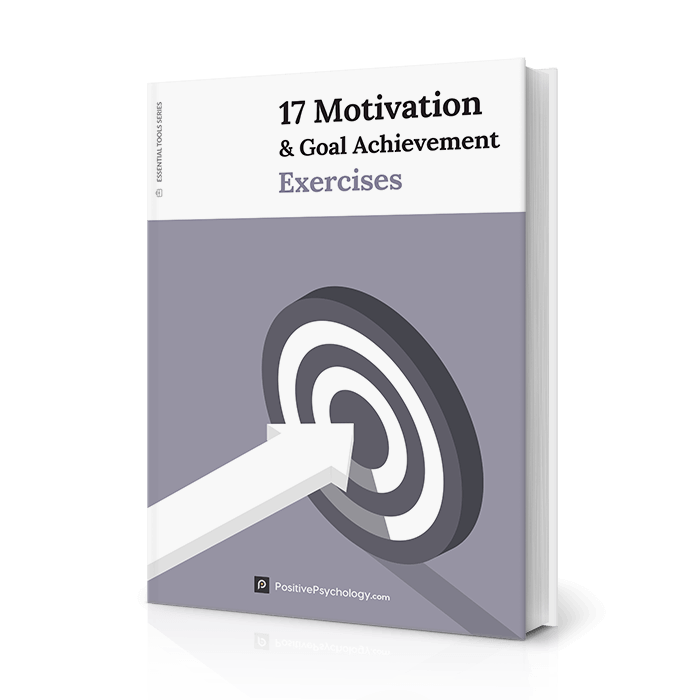Motivation in Counseling: 9 Steps to Engage Your Clients
 Client motivation is crucial to a successful outcome in counseling and heavily influenced by an underlying perception of autonomy (Ryan et al., 2010).
Client motivation is crucial to a successful outcome in counseling and heavily influenced by an underlying perception of autonomy (Ryan et al., 2010).
While many factors are involved, the counseling approach and alliance formed between the client and counselor are key in promoting such autonomy throughout treatment.
Understanding the client’s reason or need for attending counseling and engaging them in decision-making from the outset of treatment encourages motivation for ongoing attendance and a willingness to change (Ryan et al., 2010).
This article explores motivation in counseling and offers techniques and tools to promote successful treatment outcomes.
Before you continue, we thought you might like to download our three Goal Achievement Exercises for free. These detailed, science-based exercises will help you or your clients create actionable goals and master techniques to create lasting behavior change.
This Article Contains:
Motivation in Counseling Explained
Client motivation or volition is a core aspect of successful counseling, “presumably because positive and lasting results most likely occur when a client becomes actively engaged and personally invested in change” (Ryan et al., 2010, p. 194).
And yet, counselors consistently report working with clients who are resistant or not motivated to change. Alternatively, they appear superficially motivated, possibly driven by the desire for approval from the counselors or those outside treatment (Ryan et al., 2010).
As a result, skilled mental health professionals must work with and, where possible, overcome such resistance and understand existing motivation, while fostering new motivation.
It is important to begin by recognizing the types of motivation seen in clients when they enter treatment, which can impact its outcome, including (Ryan et al., 2010):
- Lack of motivation
Clients are not always motivated to enter treatment or experience the changes that may result. Such amotivation is likely to result from multiple factors and may need to be addressed by several therapeutic approaches. - External motivation
Clients are pressured to change their behavior from outside parties, such as someone entering treatment for alcoholism at their family’s wish. - Introjected motivation
Clients can pressure themselves into action in response to shame, guilt, or poor self-esteem regarding their lifestyle. - Identification and integration
Some clients genuinely recognize the value of counseling and will engage and accept responsibility in managing their behavior. - Intrinsic motivation
The client is engaged in therapy because they think it will be interesting, possibly even enjoyable, and have positive feelings regarding the change process.
Counseling approaches differ significantly in how they tackle this apparent unwillingness, some screening out unmotivated clients and others recognizing low motivation as a valuable starting point for treatment.
Where possible, counselors should seek to increase client volition and engagement by “mobilizing the forces or energy within the client in the direction of healing or change” (Ryan et al., 2010, p. 196).
How to Motivate Clients in Counseling: 9 Steps

The following are some of the core steps that help counselors connect with clients and strengthen their therapeutic alliance, crucial in building volition.
The order and selection of the steps will vary depending on the client, their situation, and the timing (modified from Nelson-Jones, 2014; Knox & Cooper, 2015; Ryan et al., 2010):
- Create a solid therapeutic alliance
A high level of collaboration and a strong therapeutic alliance can motivate clients initially and throughout treatment. - Goal setting
Goals are often set early in therapy, but this process can be revisited throughout. It is generally seen as helpful and motivating toward positive therapeutic outcomes. Setting goals and the dialogue it fosters between clients and counselors appear as valuable as the goal itself, particularly in fostering autonomy. - Agreeing on therapeutic tasks
The counselor should discuss the therapeutic relationship phases with the client, as it provides an opportunity to strengthen their alliance and foster motivation. For example, a client may want clear direction in dealing with a substance abuse problem or the space and opportunity to talk when faced with bereavement. Understanding and agreeing to the therapeutic tasks provides them with the needed direction and space. - Displaying empathy
Empathy requires that the counselor maintains deep awareness, attempting to understand the client’s needs through their eyes. Surfacing their motivation is more likely when an empathic bond is formed. - Pushing things along
Motivation will dwindle if there is no apparent progression. There will be times when the counselor will need to remind the client of the number of remaining sessions and draw conversations back toward the agreed direction. - Building trust
Without safety or security, the client is unlikely to be motivated to invest significant time and energy in their treatment.
The counselor can encourage trust by (Knox & Cooper, 2015):
-
- Maintaining a warm, welcoming, and friendly atmosphere
- Showing sensitivity to what the client brings to therapy
- Being consistent
- Being reliable
- Keeping to boundaries
- Not judging
- Sensitivity to the power dynamic
Some clients may be sensitive to a perceived power dynamic. Therefore, it is important (for their intrinsic motivation) that the client feels engaged and equal during treatment. Mutuality is achieved by forming a solid collaborative bond and displaying empathy toward the client. - Client feedback
Receiving feedback from the client can motivate both the client and counselor. The process gives the client the sense that they are fully engaged and making progress.
Helpful questions include:
-
- What did you find helpful in the session today?
- What was not so helpful in today’s session?
- Is there anything you would like more or less of in future sessions?
- Therapeutic breakdown
A breakdown in the alliance is likely to (at least temporarily) be damaging to the client’s motivation. It should be addressed early and completely. Ongoing conversations on expectations and progress will help avoid future ruptures in the alliance.
Addressing Lack of Motivation in Sessions
When possible, it is vital to focus on the positive aspects of change with clients. For example, it is more motivating to focus on the value of healthy eating than the harmful effects of poor nutritional habits.
Providing feedback that compares client behavior to national norms or what living healthily might look like can also be powerful and motivating. However, the counselor should avoid scare tactics, such as harshly judging their life choices (Sobell & Sobell, 2011).
The following techniques are all valuable for boosting motivation and engagement and can be varied throughout the treatment (modified from Sobell & Sobell, 2011).
- Affirmation
Statements made by counselors in response to what the client has said can be used to recognize their strengths and efforts to change. They should be used sparingly, or they will lose their effect.
For example, “You showed a lot of courage exploring how you felt today” or “Coming in today showed your commitment to change.”
- Asking permission
When people are treated with respect and asked, rather than told, they are more likely to discuss and consider change.
For example, “Can we talk about your eating and drinking habits?” or “Would you mind if we talked about your health condition and the effect lifestyle may have?”
- Advice/feedback
After getting permission, it is important to give clients choices rather than telling them what to do. Being neutral and nonjudgmental can empower them, allowing them to make an informed decision autonomously.
For example, “What do you know about the benefits of stopping smoking?” or “Are you interested in learning more ways to stop drinking?”
- Normalizing
Let clients know that change is not easy; many people find it difficult to change their lifestyle or how they respond to particular situations.
For example, “A lot of people report not being happy with how they look” or “Many people seek help to overcome their fears.”
- Open-ended questions
Such questions encourage the client to do most of the talking (rather than feel interrogated) and allow the counselor to respond with reflections or summary statements.
For example, “What brought you to me today?” or “What do you think it would be like if you made the changes we have discussed today?”
- Reflective listening
Paraphrasing what the client has said shows that the counselor has been listening and understands. It builds empathy and encourages the client to state their reasons for change.
For example, “It sounds like you’ve really made some progress in your relationship with your son” or “I get the sense that this has been a difficult time for you.”
- Summaries
Use active listening and empathy to summarize what the client has been talking about. It can be useful to round off a topic and move on to a new one, or to end a session.
For example, “It sounds like you have thought a lot about the arguing in your relationship. Where does that leave you?” or “You’ve talked a lot about your health issues. I can see why these lifestyle changes are so important to you.”
Engaging Resistant and Depressed Clients

Counselors may wish to adopt a more narrative approach for those experiencing depression and other conditions, offering a label without insisting it has relevance, for example (Rogers & Maini, 2016, p. 173):
“Would you describe what you are going through as depression?”
Such an approach may be helpful when therapeutic resistance is apparent. Perhaps the client lacks confidence in the process or motivation for the changes to be made.
Both for resistant or depressed clients, the following approaches or shifts in perspective can help improve the therapeutic alliance and motivation (Rogers & Maini, 2016):
- The client may have lived in mental distress for some time and will have their story to tell. Try to use their language and metaphors where possible.
- Help the client feel where in their body the experience is coming from. They may see it as a color and shape that can be pushed away or reduced in size.
- Treat the client as having a choice regarding whether they get better.
- See the client as having a life outside of their illness or situation.
Encouraging autonomy in depressed or resistant clients is likely to increase the potential for positive outcomes in counseling (Rogers & Maini, 2016).
Five essential strategies in motivating clients to change
4 Helpful Motivation Tools and Exercises
Counselors wishing to address the issue of client volition and motivation can use brief motivational enhancement interventions early in the treatment process (Ryan et al., 2010).
1. Motivational interviewing
Motivational interviewing (MI) is a powerful tool for enhancing motivation and behavioral change by focusing on the client’s readiness for change (Hagger et al., 2020; Miller & Rollnick, 2013).
The DARN acronym offers a valuable set of open-ended questions that provoke thoughts and discussions about change.
- Desire questions explore why the client wants to change.
For example, “What are you looking to gain from these sessions?”
I would like to lose some weight.
- Ability questions consider what the client could do to change without committing to making that change.
For example, “If you really did start a new career, how could you do it?”
“I could get some extra training online.”
- Reason questions engage clients who may not be ready to begin but know the reasons for change.
For example, “What are the downsides to how things are now?”
“I’m unhappy, and my family and friends aren’t seeing the best of me.”
- Need questions explore why change is needed and what that looks like.
For example, “What do you think needs to change, and how urgent is this for you?”
“I’m unhappy with the arguing in my relationship. It has to change before the baby arrives.”
2. Socratic method
The use of focused open-ended questions, known as Socratic questioning, encourages clients to reflect, bringing to their awareness hidden or new perspectives and uncovering unidentified motivations (Clark & Egan, 2015).
For example, “Is there another point of view?” or “What do you mean when you say you can’t change?”
3. Trans-theoretical model of change (TTM)
The trans-theoretical model of change proposes that in order for behavioral change to occur, the client must pass through and complete the seven stages of change listed below (Hagger et al., 2020).
The counselor can foster motivation by educating the client on the stages of change and setting tasks to move through them.
- Precontemplation – increasing awareness, hope, and confidence
- Contemplation – performing risk versus reward analysis
- Preparation – creating a change plan
- Action – implementing the change plan
- Maintenance – integrating the new behavior into their lifestyle
- Relapse prevention –revising and reimplementing new plans
- Termination – the client will no longer return to their old ways
4. Motivational Enhancement Therapy (MET)
The Motivational Enhancement Therapy approach is particularly effective at helping clients struggling with substance abuse to motivate themselves to change. It combines MI with the TTM and client-led goal setting.
Unlike MI, MET is a standalone, short, focused intervention where time is limited, typically only four sessions. The five techniques shared with MI include (Miller, 1992):
- Expressing empathy with the client to establish trust
- Developing discrepancy between where the client is and where they want to be
- Avoiding arguments by not placing the client in a defensive position
- Rolling with resistance rather than challenging the ambivalence of the client
- Supporting self-efficacy by enhancing the ability of the client to believe in their ability to make the change
Resources From PositivePsychology.com
For a successful outcome, it is crucial that the client remains motivated during counseling.
We have many free resources to help build motivation, including the following:
- Building New Habits
This simple but effective model provides the motivation to turn changes into habits, breaking them down into three elements: cue, behavior, and reward. - Querying Extremes
This powerful tool from motivational interviewing evokes change talk in clients. - Looking Back
It is helpful to remind clients what things were like before problems arose to motivate them toward life as it could be again. - Looking Forward
Encourage the client to imagine how the future would look if changes do or do not happen.
More extensive versions of the following tools are available with a subscription to the Positive Psychology Toolkit©, but they are described briefly below.
- Hope Map
How we think about the future can impact our motivation to change and determine our degree of success.
-
- Step one – Determine a clear and exciting goal you would like to achieve.
- Step two – Use the Hope Map to capture the actions and pathways needed.
- Step three – Identify and log any expected obstacles.
- Step four – Develop strategies or new pathways to overcome the obstacles.
- Step five – Capture ideas and strategies for maintaining energy and motivation.
Mentally rehearse all the steps needed to get to the goal.
- The Beyond Limitation Question Techniques
The counselor must identify the client’s most authentic goals and values. Such unedited dreams provide a wealth of emotional energy.
This exercise uses questions to explore beyond the anxiety and disbelief that blocks the client’s ability to see past their limitations, such as:
-
- What would you do if you were free from fear?
- What would you do if you knew you couldn’t fail?
- If you were granted three wishes, what would they be?
If you’re looking for more science-based ways to help others reach their goals, check out this collection of 17 validated motivation & goal achievement tools for practitioners. Use them to help others turn their dreams into reality by applying the latest science-based behavioral change techniques.
A Take-Home Message
Successful outcomes in counseling rely on motivating clients to be engaged and personally invested in change (Ryan et al., 2010).
Skilled counselors must become experts at spotting, understanding, and empathizing with the client’s motivation to seek help. Creating a solid therapeutic bond, setting goals, and encouraging client engagement makes it possible to increase the client’s sense of autonomy and foster their intrinsic motivation.
Building trust and empathy provides confidence in the counseling process and outcome. When the clients see the environment as safe and secure, they are motivated to share and become open to the possibility and potential for change.
Seeking permission regarding the next topic of the conversation shows respect for the client, their autonomy in life, and their engagement in each session.
Why not try out some general conversational approaches for encouraging motivation in clients seeking help, alongside focused techniques such as motivational interviewing, goal setting, and the Socratic method? Maintain awareness through each session and across the treatment to identify what is working and where other interventions may be helpful.
We hope you enjoyed reading this article. Don’t forget to download our three Goal Achievement Exercises for free.
- Clark, G. I., & Egan, S. J. (2015). The Socratic method in cognitive behavioural therapy: A narrative review. Cognitive Therapy and Research, 39(6), 863–879.
- Hagger, M. S., Cameron, L. D., Hamilton, K., Hankonen, N., & Lintunen, T. (2020). The handbook of behavior change. Cambridge University Press.
- Knox, R., & Cooper, M. (2015). The therapeutic relationship in counselling and psychotherapy. Sage.
- Miller, W. R. (1992). Motivational enhancement therapy manual: A clinical research guide for therapists treating individuals with alcohol abuse and dependence (vol. 2). US Department of Health and Human Services, Public Health Service, Alcohol, Drug Abuse, and Mental Health Administration, National Institute on Alcohol Abuse and Alcoholism.
- Miller, W. R., & Rollnick, S. (2013). Motivational interviewing: Preparing people for change. Guilford Press.
- Nelson-Jones, R. (2014). Practical counselling and helping skills. Sage.
- Rogers, J., & Maini, A. (2016). Coaching for health: Why it works and how to do it. Open University Press, McGraw Hill Education.
- Ryan, R. M., Lynch, M. F., Vansteenkiste, M., & Deci, E. L. (2010). Motivation and autonomy in counseling, psychotherapy, and behavior change: A look at theory and practice. The Counseling Psychologist, 39(2), 193–260.
- Sobell, L. C., & Sobell, M. B. (2011). Group therapy with substance use disorders: A motivational cognitive behavioral approach. Guilford Press.
Let us know your thoughts
Read other articles by their category
- Body & Brain (50)
- Coaching & Application (57)
- Compassion (26)
- Counseling (51)
- Emotional Intelligence (24)
- Gratitude (18)
- Grief & Bereavement (21)
- Happiness & SWB (40)
- Meaning & Values (26)
- Meditation (20)
- Mindfulness (45)
- Motivation & Goals (45)
- Optimism & Mindset (34)
- Positive CBT (29)
- Positive Communication (20)
- Positive Education (47)
- Positive Emotions (33)
- Positive Leadership (18)
- Positive Parenting (4)
- Positive Psychology (33)
- Positive Workplace (37)
- Productivity (17)
- Relationships (46)
- Resilience & Coping (38)
- Self Awareness (21)
- Self Esteem (38)
- Strengths & Virtues (32)
- Stress & Burnout Prevention (34)
- Theory & Books (46)
- Therapy Exercises (37)
- Types of Therapy (64)





What our readers think
This is a very interesting website. I’ve never had extended psychological counseling. I have friends who have though, and this article helped me to better understand lack of motivation. I’ve been told by others that I can be rather judgmental in this regard, and I don’t want to be like that at all. I consider myself a very non-judging person. I will definitely continue to browse your website. Thank you and keep up the good work.